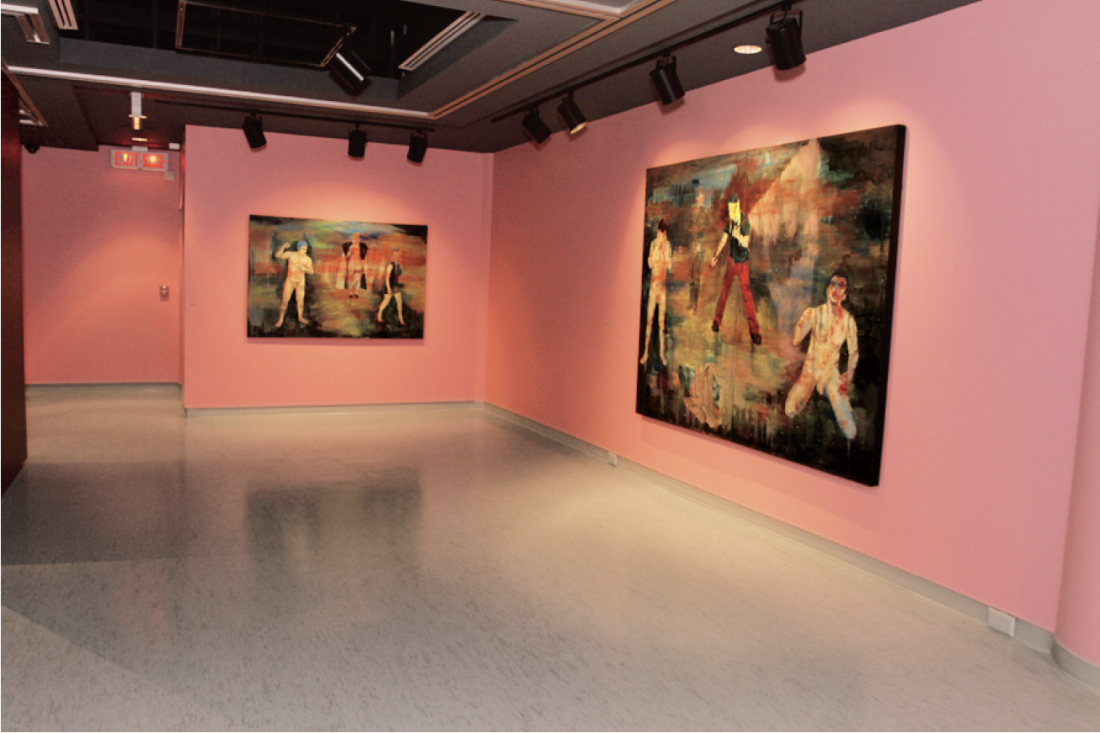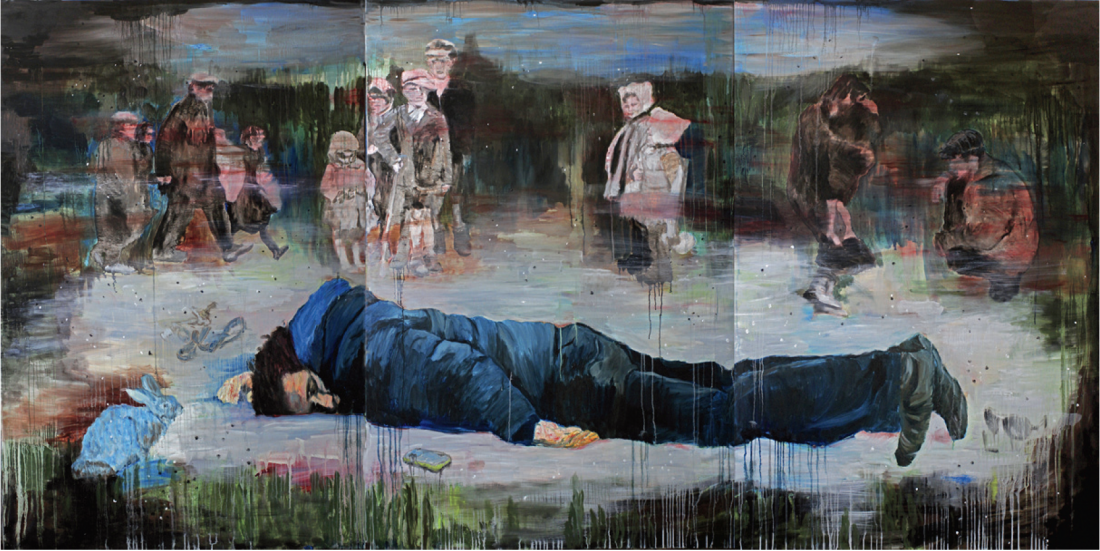Tavi Weisz
A painting nearly four metres wide blocks the overall view of Tavi Weisz’s exhibition, and sets its tone. It shows a fully dressed, seemingly unconscious man who is recognizable as the painter himself, flat on the ground. What has happened, where has he landed, and why do the groups of people in the background seem so uninterested in his fate? The painting withholds clear answers to all these questions, while its title, Above and Beyond, adds to the riddle. Time can’t be relied on either; the figure’s winter clothes are contemporary, but those of the bystanders indicate the first half of the 20th century. A cell phone and an inexplicable rabbit in the foreground begin to take on emblematic importance.
The gallery’s pink walls are striking—not a celebratory, gay pink but a dark, oppressive colour, like the skin of a drinker, or opulent velvet, and it gives the space the quality of some sort of den for a sinister art collector with a penchant for violence. The violence, though not overtly represented, is tangible in the drips and smears of the paint and the sectioning of the canvas-ses. I feel thrown into a senseless world, in someone else’s nightmarish dreams.

Tavi Weisz, “One Last Time,” 2013–14, installation view, Karsh-Masson Gallery, Ottawa. Photograph: Tavi Weisz. Courtesy the artist.
This someone else is obviously the artist; in many of the works Weisz paints himself, often naked. Faces of well-known dictators and torturers, Lenin, Hitler, Adolf Eichmann and Nicolae Ceaus¸escu are clues in the bewildering tableaux. They are shown in sometimes bizarre but plausible enough situations. Ordinary people intermingle with the tyrants, in groups or by themselves. A few provocatively dressed women call attention to themselves. In one painting Ceaus¸escu seems caught in a storm, along with an unidentified man. In another, the rabbit from Above and Beyond returns in Eichmann’s arms, making him quite ridiculous. In the painting On a Bright and Sunny Day, Hitler is seated in an armchair holding an animated conversation with a man wearing a fez. Is this just another coffee break?
These are Weisz’s nightmares. As Stefan St-Laurent writes in the exhibition essay, “His entire body of work can be seen as a cathartic process in and of itself.” Weisz, who grew up Jewish in Ceaus¸escu’s Romania, where he was drafted into the army and became an unwilling participant in the revolution of 1989, adds personal memories to stories of the Shoah that have been passed on to him from earlier generations. His exhibition, “One Last Time,” offers much more, however, than an exercise in catharsis. His intense psycho-dramatic tableaux transform personal feelings and experiences into powerful statements on the brutality, greed and decadence of the 20th century. Through his attempts to deal with his memories within his own artistic means, he reflects on a responsibility that we bear collectively in that we are all living in a history that may not be of our making. It is, however, up to us to examine this history and at least attempt to rectify its wrongs. Somewhere between our unknowing animal existence (the bunny) and our all-knowing smartphone with its infinite stream of information, the thinking required for moral decision making is up to us as individuals.

Tavi Weisz, Above and beyond, 2013, triptych, 72 x 144 inches, oil on canvas. Photograph: Tavi Weisz. Courtesy the artist.
Ripping historical figures and events from their original contexts he forms enigmatic new configurations that foreground the overall absurdity, banality and incomprehensibility of the 20th century. The philosopher Hannah Arendt coined the phrase “the banality of evil” in connection with the 1961 trial of Eichmann in Jerusalem. As she relayed in her reports on the trial, written for The New Yorker in 1962, nothing was more terrifying to her than Eichmann’s ordinariness: “the dilemma about the unspeakable horror of the deeds and the undeniable ludicrousness of the man who perpetrated them.” Her reports were a plea for a thinking life, in order to make distinctions between good and evil. Weisz’s paintings show that such philosophical thought is embedded in personal experience, intuition and emotion, and in a tangible materiality which for him means paint.
Painting has a long tradition of resistance—from the dramas of ordinary people in Bruegel’s paintings, to the biting sarcasm of James Ensor and George Grosz, to the intense idiosyncrasy of Egon Schiele, to later American artists such as Philip Guston and Leon Golub. Weisz is in good company. What he brings to the tradition is his own body, not only as represented in the paintings, but in performances as well. For “One Last Time” he projected a video clip of one of Ceaus¸escu’s hollering speeches onto a gallery wall, and stood in front of it, facing away. Falling to his knees he had his hair methodically shaved by a young woman who had entered the space. He then proceeded to throw a bucket of pink paint against the projection, furiously spreading the paint over the tyrant’s face.
Amidst the flashy, “casualist” painting that seems prevalent at this particular moment Weisz shows the continuing power of painting to critique human madness and lead the search for a moral ground. ❚
“One Last Time” was exhibited at Karsh-Masson Gallery, Ottawa, from December 13, 2013 to January 12, 2014.
Petra Halkes is a writer, curator and painter who lives in Ottawa.

